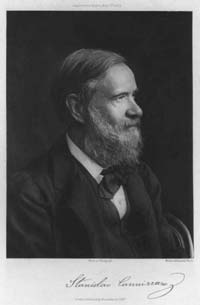
| Born: Jul 13, 18226 in Palermo |
| Died: May 10 (at age 83) |
| Nationality: Italian |
| Famous For: Cannizzaro reaction |
Stanislao Cannizzaro was a very famous Italian chemist. Today, he is remembered for the Cannizzaro reaction which is named after him. He is also known for his important role regarding the atomic-weight deliberations in 1860.
Early Years
Cannizzaro was born in the city of Palermo in Italy. He enrolled in Palermo’s University in 1841. He planned on making medicine his career, but not long after he entered the university he changed his studies to chemistry. He was the assistant to Raffaele Piria from 1845 to 1846, who was very well-known for his salicin research.
Throughout the 1848 Sicilian war of independence, Cannizzaro was an artillery officer at Messina. He also was a deputy for the Sicilian government. After Messina fell in September of 1848, he served in Taormina. Following the collapse of the revolutionary insurgents, he escaped to France in May, 1849. In Paris, Cannizzaro started working for the Michel Chevreul’s laboratory. He worked with F.S. Cloez, and in 1851, they developed cyanamide by combining ammonia and cyanogen chloride in an ethereal solution.
Career
During the same year, he was appointed professor of physical chemistry at the famous National College of Alessandria, Piedmont. In 1853, Cannizzaro conducted research on aromatic alcohols, and discovered that whenever benzaldehyde reacts with potassium hydroxide, it experiences an oxidation-reduction process which produces both benzyl alcohol and benzoic acid. This discovery is called the Cannizzaro reaction. This finding is very useful in the synthetic organic chemistry field.
In the fall of 1855, he became a chemistry professor at the University in Genoa. Later, after professorships at Naples and Pisa, Cannizzaro accepted a position at Palermo. He spent nearly ten years researching aromatic compounds and working on amines, right up until in 1871. He was then selected as the University of Rome’s chair of chemistry.
His Legacy
In addition to Cannizzaro’s contributions to organic chemistry, his “Sunto di un corso di Filosofia chimica” paper is also considered to be very significant because of its distinction between molecular and atomic weights. He demonstrated how atomic weights of various elements found in volatile substances could be deduced from molecular weights of these substances.
He also discovered how the unknown vapor densities and atomic weights of these elements can be figured out from their particular heats. Because these achievements were very important to the atomic theory, Cannizzaro was given the Royal Society’s Copley Medal in 1891.
Cannizzaro is famous for his contributions to the debate over molecules, atomic weights and atoms. He supported a theory by Amedeo Avogadro that equivalent volumes of gas that had the same temperature and pressure held equivalent amounts of atoms or molecules. He also championed the theory that equivalent gas volumes could be utilized to determine atomic weights. By accomplishing this, he presented an innovative understanding of chemistry.
In 1871, his scientific prominence secured him admittance to Italy’s senate, where he served as vice-president. He belonged to the Council of Public Instruction, as well as served other important roles in Italy’s scientific community. In his later years, he was given many awards and honors from a number of the Italy’s leading scientific societies and from other countries too.